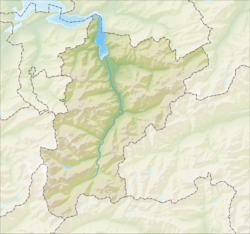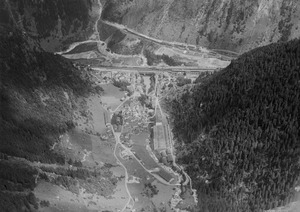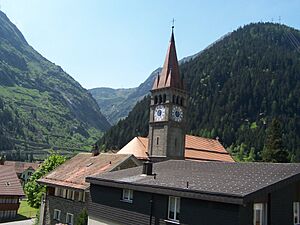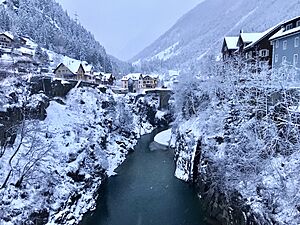Göschenen facts for kids
Quick facts for kids
Göschenen
|
||
|---|---|---|
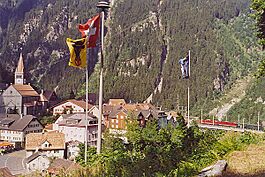 |
||
|
||
| Country | Switzerland | |
| Canton | Uri | |
| District | n.a. | |
| Area | ||
| • Total | 104.15 km2 (40.21 sq mi) | |
| Elevation | 1,111 m (3,645 ft) | |
| Population
(Dec 2020 )
|
||
| • Total | 428 | |
| • Density | 4.109/km2 (10.643/sq mi) | |
| Postal code |
6487
|
|
| Surrounded by | Andermatt, Gadmen (BE), Gurtnellen, Hospental, Oberwald (VS), Realp, Wassen | |
Göschenen (which is also called Casinotta in Italian and Caschanuttais in Rumantsch) is a village and municipality in the canton of Uri in Switzerland. It is located at the northern entrance of the famous Gotthard tunnel. In 1875, there was a protest known as the Göschenen riots. During this time, Italian miners working on the tunnel construction asked for better working conditions and pay.
Contents
About the Name of Göschenen
The name Göschenen was first written down in 1280 as Gesschenden. It comes from an old Rumantsch word, *cascina, which means "alpine hut" or a small mountain shelter. This word was influenced by the Latin word capsum, meaning "corral," and also by the word for cheese, cascio.
Geography of Göschenen
Göschenen covers an area of about 104 square kilometers (about 40 square miles). Most of this land, around 80%, is made up of non-productive areas like rivers, glaciers, or mountains. About 11% of the land is covered by forests, and 7.3% is used for farming. Only a small part, less than 1%, has buildings or roads.
Göschenen and its railway station are very important. They are located at the northern end of both the Gotthard Road Tunnel (for cars) and the Gotthard Rail Tunnel (for trains). The village itself grew up around a bridge that crosses the Reuss River.
A famous place nearby is the Schöllenen Gorge in the Reuss Valley, between Andermatt and Göschenen. This is where you can find the legendary Devil's Bridge. There's also a very short railway line called the Schöllenenbahn that connects Göschenen railway station with Andermatt railway station through the gorge.
Until 1875, Göschenen was part of the municipality of Wassen. Today, Göschenen includes the main village and smaller areas called Abfrutt and Göscheneralp.
People and Population
Göschenen has a population of about 450 people (as of 2007). Over the past ten years, the number of people living here has decreased by about 26.9%. Most people in Göschenen speak German (about 95%). Portuguese is the second most common language, followed by Spanish.
In terms of education, about 58% of the adults in Göschenen (aged 25-64) have completed either advanced high school education or higher education, like university.
Göschenen has a low unemployment rate, which means most people who want to work can find jobs. In 2005, there were 34 people working in the primary sector (like farming), 75 people in the secondary sector (like manufacturing), and 96 people in the tertiary sector (like services).
Here's how the population of Göschenen has changed over time:
| year | population |
|---|---|
| 1837 | 344 |
| 1850 | 348 |
| 1880 | 2,992 |
| 1900 | 773 |
| 1920 | 974 |
| 1950 | 698 |
| 1960 | 1,284 |
| 1970 | 888 |
| 2000 | 511 |
| 2005 | 473 |
| 2007 | 450 |
| 2010 | 410 |
The population saw a big increase around 1880 because many workers came to the area to help build the Gotthard rail tunnel.
Weather in Göschenen
Göschenen experiences about 151 days of rain each year, receiving an average of 1424 millimeters (about 56 inches) of precipitation. The wettest month is April, with an average of 139 millimeters (about 5.5 inches) of rain over 14.2 days. May has the most days with precipitation (about 15.3 days), but the amount of rain is similar to April. The driest month is September, with about 102 millimeters (about 4 inches) of precipitation over 14.2 days.
See also
 In Spanish: Göschenen para niños
In Spanish: Göschenen para niños




